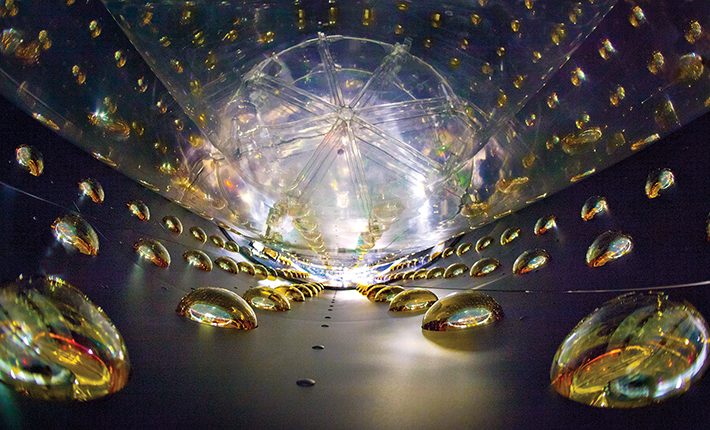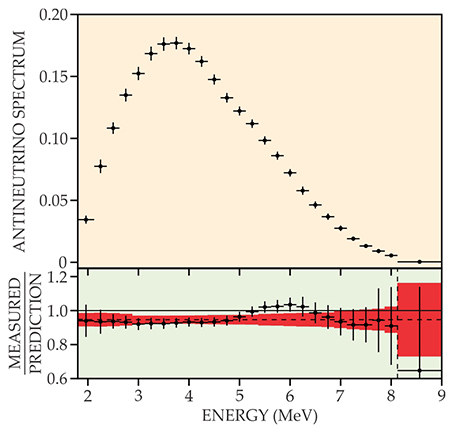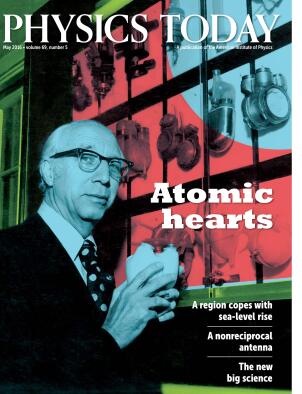The new case of missing antineutrinos
DOI: 10.1063/PT.3.3156
Once a vexing mystery, the apparent vanishing of neutrinos on their way from a source to a detector arises because the three neutrino flavor states—electron, muon, and tau—are superpositions of neutrino mass eigenstates. If the detector is not sensitive to all three flavors, the in-flight transformation of one neutrino flavor into another can mimic a neutrino deficit. (See Physics Today, December 2015, page 16
Early this decade, three experiments that track the disappearance of electron antineutrinos from nearby nuclear power plants—the Daya Bay Reactor Neutrino Experiment in China, the Reactor Experiment for Neutrino Oscillation in South Korea, and Double Chooz in France—definitively showed that θ13 was nonzero,
1
albeit smaller than the other two mixing angles (see Physics Today, May 2012, page 13
Now the latest results from Daya Bay have brought to the fore two puzzling disagreements between measurements and models of antineutrino production in reactors. 2 First, the total flux of reactor antineutrinos measured by Daya Bay fell short of predictions. Second, the shape of the antineutrino spectrum didn’t match that of the theoretical models. The discrepancies could hint at new physics beyond the standard model of particle physics. Alternatively, the results could merely be due to deficiencies in our current understanding of reactor physics.
Reactor antineutrino anomaly
The beta decay of fission fragments in nuclear reactors produces copious amounts of electron antineutrinos, upwards of 1021 each second in a gigawatt power plant. In 2011 theorists began to build models that included previously neglected nuclear effects. They also accounted for the thousands of individual beta-decay branches involved in reactor antineutrino production; 3 earlier calculations had used 30 effective branches.
The new calculations, generally considered more accurate, upped the expected reactor electron-antineutrino flux from previous estimates. Suddenly, flux measurements from the 1980s and 1990s appeared to be missing antineutrinos. The discrepancy, called the reactor antineutrino anomaly, has been interpreted by some researchers as evidence for oscillations into a hypothetical fourth neutrino—the sterile neutrino—that interacts with other particles only via gravity and whose right-handed chirality complements the left-handed chirality of the known neutrinos.
However, a direct measurement of the flux and spectrum of reactor electron antineutrinos hadn’t been made in 20 years. The Daya Bay experimenters aimed to rectify the situation. Between 2011 and 2012, the experiment’s six detectors, one of which is shown in figure 1 (two more have since been installed), monitored electron antineutrinos emitted by six nuclear reactors at distances ranging from 300 m to 2 km. Over the 217-day data-taking period, the Daya Bay detectors counted 6% fewer electron antineutrinos than the new theoretical models predicted. That number was in line with earlier flux measurements.

Figure 1. A look inside one of Daya Bay’s antineutrino detectors. The detector’s 3.1 m diameter cylindrical antineutrino target contains 20 tons of gadolinium-doped liquid scintillator and is surrounded by an array of photomultiplier tubes. An electron antineutrino is detected when it interacts with a proton to produce a positron and a neutron. The coincident detection of a positron signal and a delayed neutron signal—when a Gd atom captures the neutron and decays—distinguishes an antineutrino event from background. (Photo by Roy Kaltschmidt/Lawrence Berkeley National Laboratory.)

On closer examination, the shape of the antineutrino spectrum also veered from theoretical expectations: Despite the overall flux deficit, the measurements found an excess of antineutrinos between 5 MeV and 7 MeV when compared against the new calculations. The observed excess carries a statistical significance of four standard deviations. Figure 2 shows the antineutrino spectrum and the ratio of the measured data and prediction.

Figure 2. The measured antineutrino spectrum. The lower panel shows the ratio of the measured data to the theoretical prediction. Overall, the spectrum shows a 6% deficit when compared with data, but in the 5 MeV to 7 MeV energy range, a bump in the spectrum shows up as an excess when compared against model predictions. The red band indicates the total uncertainty in the prediction. (Adapted from ref.

Chao Zhang, a physicist at Brookhaven National Laboratory and a member of the Daya Bay collaboration, explains that the shape discrepancy brings into question arguments for the existence of the sterile neutrino based on the reactor antineutrino anomaly. “If the theory didn’t predict the energy spectral shape correctly,” says Zhang, “should we trust its total flux prediction?”
Daya Bay plans to take data until 2020 to improve measurements of θ13 and the antineutrino flux and spectrum. Researchers are still puzzling over what Daya Bay’s new results mean. Nonetheless, says Daya Bay cospokesperson Jun Cao (Institute of High Energy Physics, Beijing), having “a direct precision measurement of the flux is critical to the next-generation reactor experiments.”
References
1. Y. Abe et al. (Double Chooz collaboration), Phys. Rev. Lett. 108, 131801 (2012); https://doi.org/10.1103/PhysRevLett.108.131801
F. P. An et al. (Daya Bay collaboration), Phys. Rev. Lett. 108, 171803 (2012); https://doi.org/10.1103/PhysRevLett.108.171803
J. K. Ahn et al. (RENO collaboration), Phys. Rev. Lett. 108, 191802 (2012). https://doi.org/10.1103/PhysRevLett.108.1918022. F. P. An et al. (Daya Bay collaboration), Phys. Rev. Lett. 116, 061801 (2016). https://doi.org/10.1103/PhysRevLett.116.061801
3. G. Mention et al., Phys. Rev. D 83, 073006 (2011).https://doi.org/10.1103/PhysRevD.83.073006




